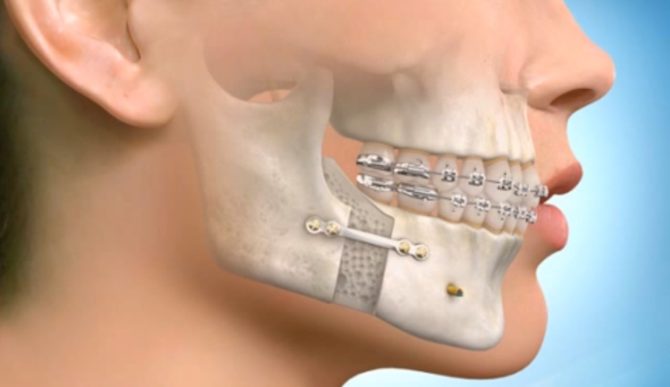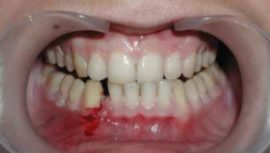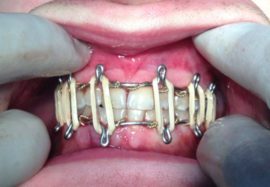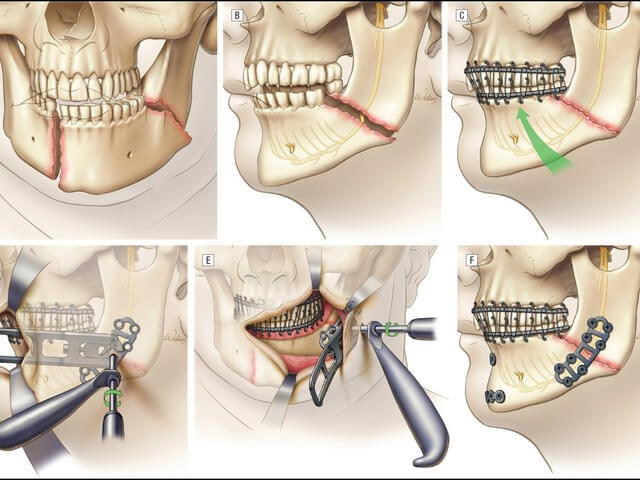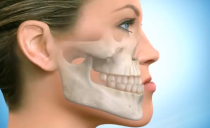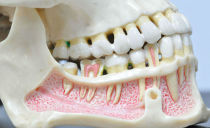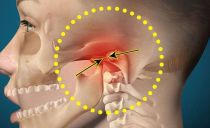Fractures of the lower and upper jaw: classification, signs, symptoms and treatment
Any injury to the bones of the skull is extremely dangerous. Most often the jaw suffers, at risk - young men aged 18 to 40 years. Fractures of the upper and lower jaw require serious and immediate treatmentTherefore, it is very important to consult a specialist on time.
Content
The main causes of jaw fracture
Such pathologies arise under the influence of mechanical stress on the bone, the strength of which exceeds its strength. Most often, fractures of the maxillofacial region (MFA) occur in the following cases:
- Traffic accidents.
- Extreme sports.
- Pronounced physical impact.
- Firearms.
Not everyone who gets into such an unpleasant situation gets a broken jaw. The bones of the skull are very strong, so the incident must be really serious. True, there are people who are more prone to non-arthral fractures of the lower and upper jaw more than others.
In the presence of the following prerequisites, the bones of the skull break more often and easier:
- Oncological diseases.
- Inflammatory processes in bone tissue.
- Infectious diseases, especially tuberculosis.
- Taking certain medications.
- Impaired bone mineralization.
- Metabolic problems.
- Acute deficiency of vitamins and minerals.
Symptoms of a jaw fracture
A bone fracture is always painful, so it is impossible not to notice it. And yet, people sometimes confuse the signs of a fracture of the jaw and dislocation and, not realizing the seriousness of the situation, try to solve the problem at home. To correctly identify the injury, you need to know its main symptoms:
- Pain that intensifies when touching the chin and any movement of the jaw.
- Unnatural bone mobility.
- Malocclusion. In many cases, a person cannot close his jaw at all.
-
Gaps almost always form in the dentition.
- In most cases, teeth break or fall out.
- Change in the relief of bones, especially in the chin area. The injury noticeably shifts it.
- Hematomas and bruises appear on the face and in the oral cavity.
- Increased salivation.
- Tongue dropping.
- In most cases, the patient is completely unable to speak normally, eat and move his jaw.
- There is a general malaise. The patient suffers from headache and dizziness. Sometimes the temperature rises, and drowsiness appears.
All of these symptoms can be considered common. They are characteristic of any type of similar injury, but there are also narrower signs on which the classification of fractures of the lower and upper jaw depends.
Classification of jaw fractures
Specialists distinguish more than a dozen different types of fractures, and the treatment of the patient depends entirely on the belonging of the injury to one or another type. First of all, fractures of the lower and upper jaw can be distinguished, but these groups are also divided into several smaller ones, depending on a number of signs.
Types of jaw fractures by severity of injury
- Closed fracture. With it, the bone is damaged, but the soft tissues around remain intact.This type of pathology is less dangerous, since treatment does not last long. Non-gunshot a closed fracture of the lower jaw without complications heals in 3-4 weeks.
- Open fracture. Bone fragments can shift to the side and damage soft tissues, blood vessels and joints. Such a pathology can be recognized by severe bleeding. More common open fractures of the lower jaw.
Open trauma is doubly dangerous because it is at high risk of bacterial damage and severe blood loss. Medical assistance should be provided immediately.
Types of jaw fractures by displacement of fragments
- Fracture without displacement. With such an injury, the bone can even be divided into multiple fragments, but they are in a standard position and do not shift in relation to each other. The crack may be incomplete. Injury is easier to treat and carries a minimum of consequences.
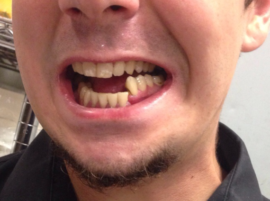 Fracture with displacement. In this case, the fragments of the jaw change their position, which causes additional pain and complicates the treatment. With open injuries, the bone is always displaced. Fracture of the lower jaw with displacement is more common than the same injury to the upper part of the skull. Damage can be recognized by severe swelling and facial asymmetry.
Fracture with displacement. In this case, the fragments of the jaw change their position, which causes additional pain and complicates the treatment. With open injuries, the bone is always displaced. Fracture of the lower jaw with displacement is more common than the same injury to the upper part of the skull. Damage can be recognized by severe swelling and facial asymmetry.- Cellular fracture. The bone breaks up into separate fragments of different sizes, which are arranged in a chaotic order. In most cases, the pathology is accompanied by damage to the soft tissues, requires immediate medical attention and long-term treatment. Often after a hospital, patients also have to go to a plastic surgeon.
Types of jaw fractures for localization of injury
Types of fracture of the lower and upper jaw are determined not only by symptoms, but also by location:
- The middle fracture is in the middle of the bone.
- If the injury is deployed at the lateral incisors, it is defined as incisive.
- A canine fracture is an injury in the area of the third teeth of the upper or lower jaw.
- A crack in the chin area is designated as mental. It is one of the most common jaw injuries due to the fact that the chin in a person sticks out noticeably.
- An angular fracture can only be on the lower jaw. It is located in the corners of this bone, closer to the base of the skull.
Doctors can use a more extensive classification of such injuries. It is hard to imagine how many types of pathology exist exactly - each case is individual in its own way.
First aid for jaw fracture
The very first thing to do if a person has broken his jaw is to call an ambulance. After this, you can take measures to alleviate the condition of the victim:
- Since damage most often occurs in the event of an accident, fights, falls, first of all, you need to make sure that nothing threatens human life.
- In the presence of several non-gunshot injuries, you first need to deal with the jaw. An exception is open fractures of other bones if the head injury is closed.
- If blood is flowing, a clean, preferably sterile, tissue should be pressed against the wound. If the damage is slight, cotton wool will do.
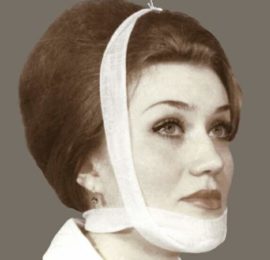 If the patient is unconscious, gently flip it to its side. Cleanse your mouth from blood clots and vomit. This should be done with extreme caution, wrapping a finger around a clean cloth.
If the patient is unconscious, gently flip it to its side. Cleanse your mouth from blood clots and vomit. This should be done with extreme caution, wrapping a finger around a clean cloth.- Then you should put the patient in a comfortable position and try not to move him anymore. If the patient is conscious, a sling-like bandage is applied to the broken jaw, as in the photo on the right.
- Ice is applied to reduce pain. If possible, it is worth giving the victim an anesthetic. In this case, the most effective injection is intramuscular injection. Of the tablets, Analgin, Naproxen, Revalgin are suitable.
Since the patient is not able to swallow, the anesthetic tablet needs to be crushed and dissolved in water.If the person is unconscious, you can pump fluid into a syringe without a needle and gently pour the medicine directly into the throat.
Jaw fracture treatment
As soon as the patient enters the hospital, he is sent for an x-ray to find out if his jaw is broken and to determine the exact location and degree of danger of injury. The stages of treatment depend on the classification of the fracture. In most cases, splinting will be done, but additional methods of therapy may be prescribed.
A special plastic device or wire construction is applied to the jaw from the damage side. In case of injury, a more complex and stiff product is used on both sides of the bone. After installing the structure in the smile area, a series of loops is formed. The hooks on the upper and lower jaw are connected with elastic bands.
The main task of splinting is to preserve the immobility of bone tissue for exactly as long as the fracture of the jaw will heal. Usually, treatment lasts from 3 weeks to six months.
With angular injuries with displacement, a suture is required. For this, a crack is exposed from soft tissues, small holes are made in bone fragments along the entire length of the fracture. Then the parts are interconnected with a special wire and covered with a soft cloth.
After the main operation, rehabilitation begins. For faster tissue regeneration, magnetic therapy, ultraviolet irradiation, calcium electrophoresis at the fracture site, or other medical procedures are used.
Jaw fracture treatment at home
After 3-4 weeks, if the fracture is simple, and nothing threatens the person, they can be discharged from the hospital. Usually, at this point, the bone does not completely overgrow, so the specialist gives a number of recommendations for continuing treatment at home:
- With an open fracture of the jaw, antibiotics are prescribed, after discharge from the hospital, you need to continue to take them at home.
- To accelerate healing, multivitamin complexes are prescribed, rich in calcium and substances that improve its absorption.
- It is possible to treat a crack in the jaw with folk remedies, but before using them, you need to consult a doctor. Most experts approve of paraffin therapy.
- After removing the tire, you will have to wear a special retaining bandage for several months - first it is worn for the whole day, and then only for the night.
- If the tire has already been removed, the jaw needs to be developed. Every day for several minutes a person should do simple exercises: move the jaw from side to side, open and close your mouth wide.
All of these recommendations can be used only as an addition to the basic treatment that takes place in the hospital. It is impossible to cure a fracture without medical assistance.
Jaw fracture nutrition
Due to trauma, the process of eating is complicated, because the patient is even painful to open his mouth, not to mention chewing. And yet, a person should receive a sufficient amount of nutrients. It depends on how long the crack in the jaw will heal. With a deficiency of nutrients, the duration of treatment increases, and more complications appear, so the patient is fed according to certain rules:
- A rubber tube is inserted directly into the patient's throat, through which a nutrient solution or liquid food will be introduced. Typically, the tube is placed through an area where one or more teeth are missing, which is quite often with injuries to the skull bones. If there is no clearance, then the tube is placed in the mouth through the gap after the wisdom tooth. Such food is convenient in that it is possible even at home.
- If a patient with a broken jaw is in intensive care, doctors make droppers with a special solution rich in nutrients, vitamins and minerals. If this is not possible, a nutritious enema is used.
- The basis of the diet is ground meat mixed with milk or broth, baby food, puree soups, fruit and vegetable dishes, liquid cereals.
- The patient will need more calories than he usually needs. In addition, the vitamin-mineral nutritional value is increased.
The consequences of a jaw fracture
Such a complex injury cannot pass without a trace, even with proper treatment, there are certain complications:
 Deformation of facial features. There is an asymmetry, sometimes very noticeable (see photo). Typically, this consequence is manifested in fracture of the jaw with displacement. With less dangerous pathologies, such a change is almost imperceptible.
Deformation of facial features. There is an asymmetry, sometimes very noticeable (see photo). Typically, this consequence is manifested in fracture of the jaw with displacement. With less dangerous pathologies, such a change is almost imperceptible.- Loss of teeth and their curvature. In many cases, gaps between the teeth are formed, the bite is broken.
- The remaining teeth can stagger when chewing, most often this phenomenon is observed after an angular fracture.
- In the vast majority of patients, after the treatment of a fracture, the jaw crunches. Moreover, this can last until the end of life.
- Due to liquid nutrition, problems with the gastrointestinal tract occur.
You need to understand that head injury is always dangerous. Only proper and timely medical care will minimize the consequences.

